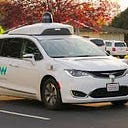How Far Should LiDAR “See”?
Recently, the race to present a long detection range system in the automotive LiDAR industry has heated up.
Velodyne boasted the detection ranges of a 10% reflective target from 50m achieved by the veteran HDL-64E to 265m by the recent Alpha Prime. At the same time, Luminar is promising to detect 10% reflective objects at 250m with the Iris system. Moreover, Argo AI’s LiDAR system is designed to detect “dark objects” at 400m. Yet, arguably, the current record is held by AEye’s “iDAR” that can detect two vehicles at a remarkable distance of 1000m, as detailed in VSI labs’ test report.
Well, at the same time, a few questions are crossing my mind:
- Do we really need to detect vehicles at 1000m using an automotive LiDAR system? If not, what is the required detection range? In LiDAR systems, there are always tradeoffs between various system characteristics. Therefore, a major improvement in one parameter (significantly above the required level) will mean an unnecessary degradation in other ones.
- How should we define the target detection range for a LiDAR system? What are the appropriate test conditions? Do we compare “apples to apples” when we’re comparing detection ranges of different LiDAR systems?
This article will answer the first question by guiding you through a simplified analysis method for finding out the required LiDAR system detection range.
A dedicated article that will follow is going to address the second question.
Vehicle Stopping Distance
A suitable scenario for defining the required detection range of a LiDAR system is detailed below.
Let’s assume a stationary obstacle laying on the road along the vehicle’s path, which may pose a potential danger to it. Moreover, the car can’t get around that obstacle but must stop in front of it. To make things even more interesting, let’s suppose it’s on a wet highway road.
According to this scenario, the required detection range for the LiDAR system is equal to the minimum stopping distance of the vehicle.
The stopping distance is the sum of the reaction distance and braking distance. Reaction distance means the distance the vehicle passes from the moment the obstacle is detected until the braking is activated.
To avoid making this analysis too complex and lengthy, we’ll make several work assumptions:
- Instead of using a complete model of the vehicle, tires, and road surface to calculate the accurate braking distance, we’ll use a simplified formula presented below.
- Since we already assumed a wet road, which means relatively low friction, we’ll consider the tires are in good condition.
- The braking distance is along a direct route, not a turn.
- Since an algorithm rather than a human driver will process the LiDAR’s detection, we can assume a very conservative reaction time of 200ms (5 frames at 25Hz frame rate).
After setting the scenario and work assumptions, we’re ready to make the calculation.
To stop a driving car, we need to convert all its kinetic energy to heat energy by friction:
Where v0 is the initial vehicle speed [km/h], m — vehicle mass [kg], d — braking distance [m], µ — friction coefficient, and g — free-fall acceleration [m/s2].
Accordingly, the stopping distance is:
t_reaction is measured in milliseconds. You can find a detailed explanation of this formula in the following paper: Effect of Adverse Weather Conditions on Vehicle Braking Distance of Highways.
Therefore, once we define the appropriate vehicle velocity and road friction coefficient, we’ll be able to calculate the required detection distance.
Friction Coefficient
The friction coefficient µ depends on the road surface type and wetness.
Since our scenario takes place on a highway road, the appropriate surface type is asphalt. However, there is no consensus as to the friction coefficient of wet asphalt. As you can see in the following table, each study states a different value:
Based on the table above, we can assume that 0.5 is a conservative but realistic friction coefficient for wet asphalt.
Vehicle Velocity
To determine the initial vehicle velocity, we should look at the speed limit on a highway. As seen in the following article, there is a significant variance in speed limits between different countries. However, in most of them, the speed is limited to 140km/h. Then, of course, there are the notorious German autobahns with no speed limit at all, but the advisory speed is still 130km/h. Besides, 160km/h is allowed only in some spots on UAE’s highways. Therefore, if we assume an initial speed of 150km/h on a wet road, we’ll be on the safe side in most cases.
In addition, we should consider the following as well: assuming a Level 3–5 autonomous vehicle, it’s by definition driving according to the regulation. Moreover, if the road is wet, we can assume it's a rainy or cloudy day. Meaning, the ambient light is lower than on a sunny day, which reduces the noise level and simplifies LiDAR’s target detection.
Required Detection Range
By using the values we found for friction coefficient and vehicle velocity, we can calculate the estimated stopping distance:
If we take a 10% safety margin, we get 202m. Meaning, an applicable requirement for an automotive LiDAR detection range should be 200m.
In other words, if there is an obstacle in the middle of a wet highway, and there is no way to get around it, it’s sufficient to detect it at about 200m to stop safely. Although this scenario is assumed to be an extreme case by itself, the requirement is still significantly lower than the claimed performance by most vendors! Of course, one may alter some of the work assumptions presented above and reach slightly longer required detection distances, but not by a factor of x2 or even more. Would you mind sharing with me if you have any comments on the calculation or its result?
Consequently, the question is, what are the hidden costs of these exaggerated detection range values? Some possible costs can be increased power consumption, degraded angular performance, larger system dimensions, higher product cost, etc.
Below is an example of the potential power gains from decreasing the detection range to what I consider is the required level.
Potential Power Gains
Let’s analyze Aeye iDAR vehicle detection results at 1000m and see if it’s possible to decrease the emitted optical power and still comply with the performance requirements above.
According to a study presented by Ford, a white glossy paint at 1550nm (the wavelength where Aeye’s LiDAR system operate) is almost 50% reflective:
An increase in optical power translates to a root square increase in distance. Meaning, by guaranteeing detection of a 10% reflective target at 200m, we ensure enough optical power is received in the system from a 50% reflective target positioned at a 2.24 longer distance, which is roughly 450m.
Accordingly, Aeye can decrease the emitted optical power by about 33%, decreasing vehicle detection distance from 1000m to 450m and still detect it at a 2.25 longer range than the stopping distance. Of course, a 1000m detection range is a good PR, but I won’t be surprised if, most of the time, Aeye’s iDAR is working at much lower power levels.
In conclusion, one should first focus on achieving a low-cost, small, efficient, and highly reliable system that fully complies with all product requirements before stretching the boundaries beyond the required limits.
Feel free to share your thoughts in the comments below or contact me on LinkedIn.

